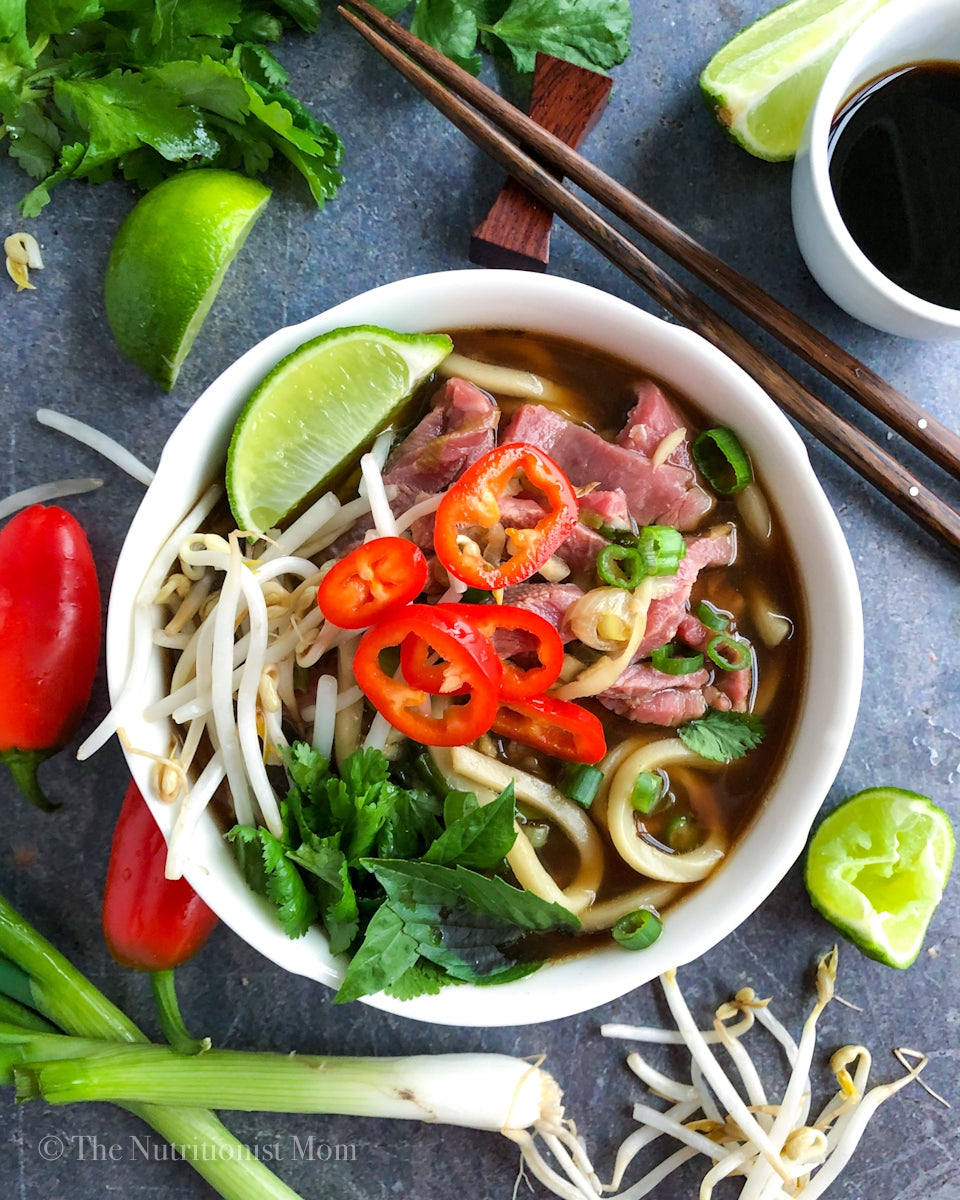VIETNAMESE BEEF NOODLE SOUP (PHO)

Have you had pho (pronounced “fuh”) before? I absolutely love Vietnamese food, and this Vietnamese Beef Noodle Soup (Pho) tastes remarkably close to the authentic version! Best of all, it’s ready to eat in about 30 minutes! It’s got thick noodles, warming bone broth, tender beef, fresh herbs, and great macros. I make this whenever I’m craving pho (it’s so good I don’t need to order out anymore)… or when I’m feeling under the weather.
Did you know? Garlic boosts immune function, and can even reduce the symptoms of the common cold. Ginger helps digestion, reduces nausea and may help fight the flu too!

The base of this Vietnamese Beef Noodle Soup (Pho) is organic beef bone broth (it’s just under $3 at Walmart). You could make your own, but this is a quick and easy version! First, I sauté some green onions, ginger, and garlic in a soup pot with a little avocado oil. Avocado oil is a good high-heat oil that’s also anti-inflammatory.
Next, I pour in six cups of organic beef bone broth and season with coconut aminos, fish sauce, and Chinese five spice powder (NOT optional). Some recipes call for whole anise that you have to fish out later, but to me, this is easier. I prefer coconut aminos to soy sauce because they’re gluten-free, lower in sodium, and a bit sweeter.

Then, I add my noodles straight to the broth. No need to cook them separately! You can use flat rice noodles, but I used Fortune Udon Noodles by JSL Foods. You can find Fortune Udon noodles at Target, Walmart, United Supermarkets, HEB Supermarkets, or on their website. Get a coupon for free noodles here! Gluten-free products available.

Also, follow JSL Foods on Facebook, Twitter, or Instagram for recipes and new products!
For the beef, I use organic or at the very least grass-fed beef. Grass-fed has up to five times the anti-inflammatory omega-3s compared to corn-fed beef! (source) Part of the reason people avoid red meat is that it’s supposed to be inflammatory… well, not so much if it’s grass-fed. “Organic” further certifies the cattle were fed organic feed and not given antibiotics or hormones. I also look for leaner cuts like sirloin tip, skirt steak, top sirloin, top or bottom round.

Depending on how you’re serving your pho, you can either (1) add the raw beef straight into the pot of simmering broth (it will cook through in about 2 minutes); OR (2) add to the bowl raw and pour scalding hot broth over top, cooking the beef instantly. I suggest method number one if you’re meal-prepping this.
When ready to eat, top your pho with fresh mung bean sprouts, Thai chili peppers, basil, cilantro, a squeeze of fresh lime, and maybe a little fresh mint, hoisin, or sriracha if you like!
Here’s the printable recipe for this Vietnamese Beef Noodle Soup (Pho). I hope you’ll rate and comment below if you try it 😉
This post contains affiliate links and is sponsored by JSL Foods.
Vietnamese Beef Noodle Soup (Pho)
Ingredients
- 1 tbsp. avocado oil
- 6 stalks green onion chopped
- 1 tbsp. fresh ginger minced
- 4 tsp. (4 cloves) fresh garlic minced
- 6 cups beef bone broth not regular beef broth
- 2-3 tbsp. coconut aminos to taste
- 1 tbsp. fish sauce
- 1/4 tsp. Chinese five spice powder
- 14 oz. udon noodles (or 6 oz. dry rice noodles) I used Fortune brand udon noodles
- 12 oz. lean grass-fed beef (top or bottom round, tip sirloin) sliced thin
- 2 cups mung bean sprouts
- 1/4 cup fresh cilantro
- 1/4 cup fresh basil
- 4 medium Thai chile peppers sliced thin
- 4 wedges fresh lime
Instructions
- Heat avocado oil in a large soup pot over medium heat.
- Sauté onion, ginger, and garlic until fragrant, about 1 minute.
- Add beef bone broth, coconut aminos, fish sauce, and five spice.
- Bring to a low boil, then add noodles. Cook noodles about 2 minutes until softened.
- If meal prepping, simply add thinly sliced beef to simmering broth and turn off heat. If serving fresh, add 3 oz. raw beef to each of four bowls and pour scalding hot broth over top.
- When ready to eat, top each bowl with ½ cup mung bean sprouts and 1 tbsp. each cilantro and basil, 1 sliced chili pepper, and a lime wedge. You can also add fresh mint, hoisin, or sriracha to taste.
- Leftovers will keep in the fridge in an airtight container up to one week, but taste best if eaten within three days. Be sure to store garnishes in a separate sealed container until ready to eat.
Notes
Also in Blog

CHOCOLATE PEANUT PROTEIN CANDY BARS (VEGAN)

PUMPKIN CHIP PROTEIN BREAD (GLUTEN FREE, DAIRY FREE)
This Pumpkin Chip Protein Bread has a rich, tender texture full of pumpkin spice and chocolate chips (no dry protein bread here). The kids and I can't get enough! Best of all, it's gluten-free, dairy-free, nut-free and easily made egg-free and vegan.




